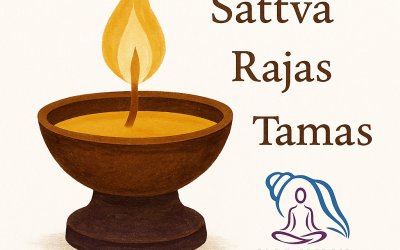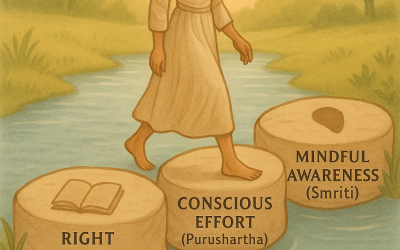Beyond the Mat: Practices & Resources
Welcome to Yoga Therapy Insights, where we explore valuable knowledge from yoga therapy to support areas such as sleep quality, joint health, stress resilience, nervous system regulation, and much more.
Whether you’re new to yoga therapy or looking to deepen your practice, these insights will guide you in enhancing your body-mind connection. Join us as we uncover ways to use yoga therapy for healing, empowerment, and lasting transformation.
Listening Before It Shouts: Understanding Anxiety Through the Lens of Yoga Therapy
5 Ways to Calm the Anxious Mind
An anxious mind is not a broken mind — it’s one that’s been overworking to keep you safe. Through the lens of yoga therapy, anxiety can be seen as excess movement of prāṇa — too much air and energy without grounding. The practice, then, is not to fight anxiety but to anchor it.
This guide offers five simple ways to begin:
– Listen to Your Body before it shouts through fatigue or tightness.
– Use Your Breath as a steady anchor in moments of overwhelm.
– Find Your Triggers and gently release what drains your energy.
– Create Micro Rituals of stillness — between calls, before bed, in small pauses.
– Nourish Through Āhāra (Food) — warm, calm, and sattvic choices that soothe the nervous system.
These are not quick fixes, but daily acts of remembering: peace is already within you, waiting to be practiced.
Yoga Therapy for Athletes: Balancing Strength, Flexibility, and Recovery
Yoga Therapy for Athletes: Balancing Strength, Flexibility, and Recovery
Athletes train hard — cycling long distances, sprinting, or competing on the court. But repetitive movement patterns often overwork some muscles while leaving others neglected, creating imbalance, fatigue, and risk of injury. Add the pressure of performance, and both body and mind carry a heavy load.
Yoga therapy offers a personalized approach to restore balance. By strengthening weak areas, releasing tightness, and integrating mindful recovery, it helps athletes move more efficiently, prevent injuries, and manage stress.
Understanding Neck Pain Through the Lens of Yoga Therapy
Neck pain is one of the most widespread modern health complaints, but its roots often extend far beyond the cervical spine itself. From weak core muscles and shallow breathing to stress, jaw tension, and even the way we stand on our feet, multiple factors can silently contribute to chronic discomfort and more severe cervical issues. In this post, we explore how yoga therapy views neck pain as a whole-body challenge—and how addressing posture, breath, and mindful movement can relieve strain while preventing future problems.
How Group Yoga Therapy Differs from Regular Yoga Classes
Both yoga and yoga therapy offer beautiful gifts—they simply serve different needs. A dynamic vinyasa class can leave you energized and empowered, while a restorative session might melt away stress and tension. Group yoga therapy, while sharing yoga's essence,...
Healing Starts With Breathing: Why Prāṇāyāma is the Foundation of All Healing
Healing Starts With Your Breath
Breath is more than oxygen — it’s the bridge between body, mind, and spirit. In yoga therapy, conscious breathing (prāṇāyāma) is the first step toward healing anxiety, balancing energy, improving sleep, easing pain, and deepening mindfulness. Backed by both ancient wisdom and modern science, breathwork empowers you to shift your nervous system, release tension, and reconnect with your inner calm.
Letting Go: An Inner Minimalism
Letting go isn’t always loud or dramatic. Often, it’s quiet—a subtle release of what no longer aligns with your truth. In yoga, this is known as vairāgya, the art of non-attachment. It’s not about rejecting life, but about loosening your grip on thoughts, identities, and habits that weigh you down.
Imagine holding a hot coal—your suffering doesn’t end until you release it.
This blog explores how yogic philosophy invites us into a kind of inner minimalism, where letting go becomes a daily practice of choosing peace over clutter, clarity over confusion, and presence over pressure.
How Yoga Therapy Supports You Through Wellness, Illness, and Recovery
🧘♀️ 3 Ways Yoga Therapy Supports Your Health 🌿
Yoga therapy isn’t just for recovery—it’s a whole-person approach for every stage of your wellness journey.
Here’s how it can support you:
✨ 1. Wellness & Prevention
Build resilience, regulate stress, and support long-term vitality with breath, movement & routine.
🩺 2. Managing Health Conditions
Gentle, personalized practices to complement treatment for anxiety, back pain, diabetes & more.
💗 3. Recovery & Rehab
Support healing post-surgery, trauma, or illness—physically, emotionally & energetically.
Balance in Yoga Therapy: A Multi-Dimensional Concept
Balance in Yoga Therapy isn’t just about standing steady—it’s about aligning body, mind, energy, lifestyle, and spirit. Through movement, breath, rhythm, and awareness, yoga therapy guides us back to center—again and again.
Sattva, Rajas, Tamas: What They Mean for Your Mind, Body, and Healing
In yoga therapy, understanding how the mind, body, and energy interact is key to healing. Ancient teachings describe these dynamics through the lens of the three gunas—Sattva (clarity), Rajas (activity), and Tamas (stability). Rather than labeling them as good or bad, yoga helps us work with these qualities to support balance, insight, and transformation. This article explores how the gunas shape our daily experiences—and how yoga therapy gently restores harmony through breath, movement, rest, and awareness.
Three Pillars of Inner Transformation: Ancient Wisdom for Modern Lives
In yoga therapy, transformation doesn’t come as a flash of enlightenment—it unfolds through quiet, consistent moments of awareness. It’s in how we breathe through resistance, how we return to the body when the mind wanders, and how we meet our own suffering with curiosity instead of judgment.
This practice isn’t about fixing what’s broken. It’s about uncovering what’s already whole beneath the noise. The body holds memory. The breath holds insight. And through guided movement, stillness, and reflection, yoga therapy offers a safe space to meet yourself—gently, honestly, and without rush.
Real healing, the Upanishads remind us, begins when knowledge meets personal effort and is held in steady awareness. In this way, yoga therapy becomes not just a practice, but a path.










